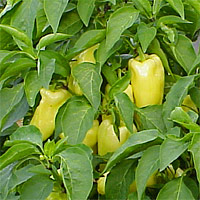Pepper

The brilliant hues and full-bodied flavors of peppers have assured them a central role in many of the world's cuisines.
About This Plant
The glistening greens of the leaves and the rainbow of colors of the ripening peppers -- red, yellow, orange, green, brown or purple -- make pepper plants an ornamental, as well as delicious, addition to the garden. Sweet bell peppers go well with just about anything and are wonderful eaten right out of the garden, while the hotter varieties spice up many recipes. Stuffed peppers, pickled peppers, fried peppers -- peppers fit in, deliciously, everywhere. Peppers like warmth, so wait to plant until the soil and air temperature has warmed up reliably.
Site Selection
Select a site with full sun and well-drained soil. Prepare the garden bed by using a garden fork or tiller to loosen the soil to a depth of 12 to 15 inches, then mix in a 2- to 4-inch layer of compost.
Planting Instructions
Plan to set out home grown or purchased transplants after the last spring frost date. Start plants indoors in flats or pots 8 to 10 weeks before the average last frost date.
Set hot pepper plants 12 to 15 inches apart, larger bell types 15 to 18 inches apart. Provide windbreaks to minimize transplant shock.
Care
Provide deep watering weekly for pepper plants. Support bushy, heavy-yielding plants with 2-foot-high cages, or stake them. Apply heavy organic mulches when summer heat begins to peak. Temperatures over 90 degrees F can cause buds and blossoms to drop; the condition is more serious if humidity is low also. Pests are not a serious concern. However, contact your local County Extension office for controls of common pepper pests such as corn borers, flea beetles, and leaf miners.
Harvesting
Most peppers, except for a few varieties like Sweet Banana, are green when young. Though bell peppers come in many colors, such as red, yellow, and purple, you can eat any of them in the green stage. However, they are sweeter if you let them ripen until the color is fully developed. Harvest by cutting through the stem of each fruit with a knife or with pruners. You can have an almost-continuous harvest from your pepper plants by cutting often, as this encourages the plant to keep blossoming, especially in the beginning of the summer.






 The brilliant hues and full-bodied flavors of peppers have assured them a central role in many of the world's cuisines.
The brilliant hues and full-bodied flavors of peppers have assured them a central role in many of the world's cuisines.